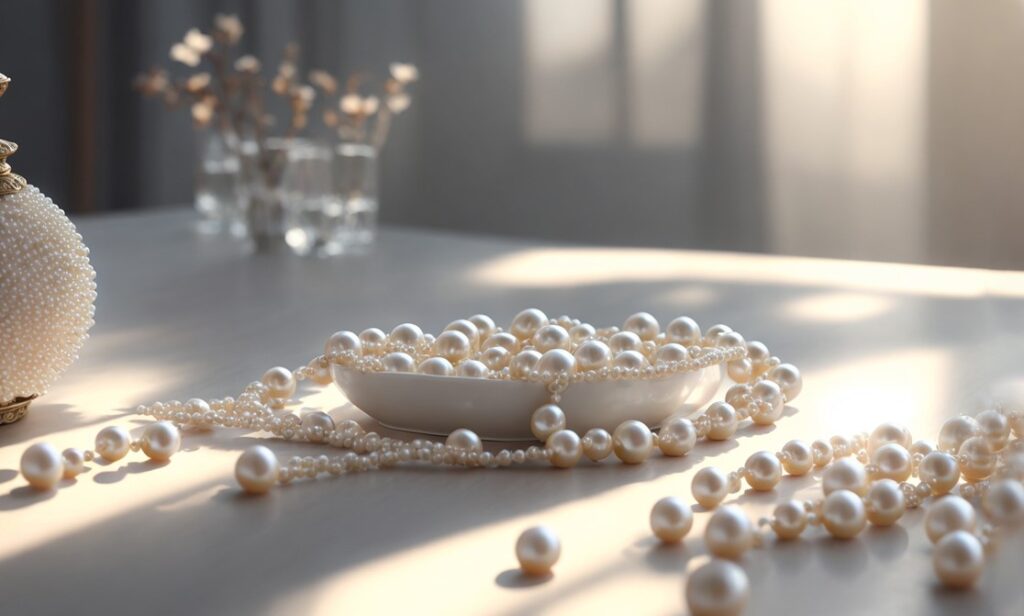Pearls, with their iridescent glow and smooth surface, have captivated humanity for millennia. Unlike other gemstones formed deep within the earth, pearls are born from a living creature’s remarkable defense mechanism. These organic gems hold a special place in our history, adorning royalty, inspiring myths,
and symbolizing a range of profound emotions. This article delves into the fascinating world of pearls, exploring their formation, cultural significance, varieties, and practical considerations for caring for and incorporating them into your life.
A Marvel of Nature: How Pearls Form
The story of a pearl begins within the watery depths, where mollusks like oysters, mussels, and abalone reside. When a foreign object, such as a grain of sand or a parasite, finds its way inside the mollusk’s shell, an irritation occurs. As a defense mechanism, the mollusk secretes a layer-by-layer coating of nacre, the same iridescent material that lines its shell. Over time, this nacreous coating envelops the irritant,
gradually forming a pearl.
The environment and the type of mollusk significantly impact a pearl’s characteristics.
Different mollusk species produce pearl in a variety of colors, from classic white and cream to
vibrant pinks, oranges, and even blacks. The size and shape of the irritant and the duration of the nacre secretion influence the pearl’s form, ranging from perfectly round to baroque (irregular) shapes.

A Timeless Treasure: Pearls Throughout History
Pearls boast one of the longest histories of any gem. Evidence suggests their use as adornment dates back as far as 6,000 years ago. Ancient civilizations across the globe, from China and India to Rome and Egypt, prized pearls for their beauty and rarity.
- China: Historical records indicate China’s fascination with pearl dates back to 2200 BC. They were considered symbols of purity, wealth, and wisdom, often reserved for royalty and nobility.
- India: In India, pearl were associated with the moon and believed to bring good luck, prosperity, and emotional balance. Mughal emperors were renowned for their love of pearls, incorporating them into elaborate jewelry and garments.
- Rome: In ancient Rome, pearl were a symbol of wealth and status. Only the very wealthy could afford these precious gems, and they were often used to adorn statues of gods and goddesses.
- Egypt: Egyptians valued pearl for their connection to Isis, the goddess of protection and motherhood. Pearls were frequently used in funerary practices, believed to safeguard the deceased in the afterlife.
Pearls have also captured the imagination through myths and legends. In some cultures,
they were believed to be formed from tears of the gods or mermaids. Japan has a beautiful legend about a pearl diver who retrieved a luminous pearl from the depths of the ocean, bringing prosperity to his village.
A Spectrum of Beauty: Varieties of Pearls
The world of pearls is far more diverse than one might initially think. Here’s a glimpse into the differen types of pearls available:
- Natural Pearls: These incredibly rare gems are formed entirely by chance within wild mollusks.
- Due to overharvesting and pollution, natural pearl are highly valuable and rarely seen on the market today.
- Cultured Pearls: The vast majority of pearl available today are cultured pearl. In the early 20th century, Kokichi Mikimoto, a Japanese entrepreneur, perfected the technique of implanting a nucleus into a mollusk, prompting it to produce a pearl. Cultured pearl come in a wider variety of colors,
- sizes, and shapes than natural pearl and are considered a more sustainable option.
- Akoya Pearls: These classic white or cream pearl are renowned for their exceptional luster and are primarily cultured in oysters off the coast of Japan.
- Tahitian Pearls: Also known as black pearl, Tahitian pearl boast a captivating range of colors,
- from deep black to silver and green. They are known for their baroque shapes and larger sizes.
- South Sea Pearls: These luxurious pearls come in white, cream, and golden hues. They are prized for their large size, thick nacre, and exceptional luster.
- Freshwater Pearls: Cultured in freshwater mussels, these pearl come in a variety of colors and shapes, often featuring a beautiful button or rice shape.
Beyond Beauty: The Meaning and Symbolism of Pearls
Pear transcend mere adornment; they carry a wealth of symbolic meaning across cultures. Here are some of the most common associations:
- Purity and Innocence: The white color of pearl has often been linked to purity, innocence, and new beginnings. This symbolism makes them a popular choice for wedding jewelry.
- Wisdom and Knowledge: Inpen_spark



